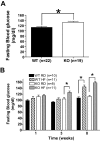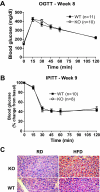The fatty acid receptor GPR40 plays a role in insulin secretion in vivo after high-fat feeding
- PMID: 18559658
- PMCID: PMC2518494
- DOI: 10.2337/db08-0553
The fatty acid receptor GPR40 plays a role in insulin secretion in vivo after high-fat feeding
Erratum in
- Diabetes. 2008 Nov;57(11):3166
Abstract
Objective: The G-protein-coupled receptor GPR40 is expressed in pancreatic beta-cells and is activated by long-chain fatty acids. Gene deletion studies have shown that GPR40 mediates, at least in part, fatty acid-amplification of glucose-induced insulin secretion (GSIS) but is not implicated in GSIS itself. However, the role of GPR40 in the long-term effects of fatty acids on insulin secretion remains controversial. This study aimed to test the hypothesis that GPR40 plays a role in insulin secretion after high-fat feeding. RESEARCH DESIGN AND METHOD GPR40 knockout (KO) mice on a C57BL/6 background and their wild-type (WT) littermates were fed a high-fat diet (HFD) for 11 weeks. Glucose tolerance, insulin tolerance, and insulin secretion in response to glucose and Intralipid were assessed during the course of the diet period.
Results: GPR40 KO mice had fasting hyperglycemia. They became as obese, glucose intolerant, and insulin resistant as their WT littermates given HFD and developed a similar degree of liver steatosis. Their fasting blood glucose levels increased earlier than those of control mice during the course of the HFD. The remarkable increase in insulin secretory responses to intravenous glucose and Intralipid seen in WT mice after HFD was of much lower magnitude in GPR40 KO mice.
Conclusions: GPR40 plays a role not only in fatty acid modulation of insulin secretion, but also in GSIS after high-fat feeding. These observations raise doubts on the validity of a therapeutic approach based on GPR40 antagonism for the treatment of type 2 diabetes.
Figures




Similar articles
-
Point mutation of Ffar1 abrogates fatty acid-dependent insulin secretion, but protects against HFD-induced glucose intolerance.Mol Metab. 2017 Oct;6(10):1304-1312. doi: 10.1016/j.molmet.2017.07.007. Epub 2017 Jul 18. Mol Metab. 2017. PMID: 29031729 Free PMC article.
-
Alteration of the glucagon axis in GPR120 (FFAR4) knockout mice: a role for GPR120 in glucagon secretion.J Biol Chem. 2014 May 30;289(22):15751-63. doi: 10.1074/jbc.M114.568683. Epub 2014 Apr 17. J Biol Chem. 2014. PMID: 24742677 Free PMC article.
-
Global deletion of G protein-coupled receptor 55 impairs glucose homeostasis during obesity by reducing insulin secretion and β-cell turnover.Diabetes Obes Metab. 2024 Oct;26(10):4591-4601. doi: 10.1111/dom.15816. Epub 2024 Aug 7. Diabetes Obes Metab. 2024. PMID: 39113250
-
The long-chain fatty acid receptor, GPR40, and glucolipotoxicity: investigations using GPR40-knockout mice.Biochem Soc Trans. 2008 Oct;36(Pt 5):950-4. doi: 10.1042/BST0360950. Biochem Soc Trans. 2008. PMID: 18793167 Review.
-
Modulating GPR40: therapeutic promise and potential in diabetes.Drug Discov Today. 2013 Dec;18(23-24):1301-8. doi: 10.1016/j.drudis.2013.09.003. Epub 2013 Sep 16. Drug Discov Today. 2013. PMID: 24051395 Review.
Cited by
-
Orphan GPCRs in Neurodegenerative Disorders: Integrating Structural Biology and Drug Discovery Approaches.Curr Issues Mol Biol. 2024 Oct 19;46(10):11646-11664. doi: 10.3390/cimb46100691. Curr Issues Mol Biol. 2024. PMID: 39451571 Free PMC article. Review.
-
Metabolic and Molecular Amplification of Insulin Secretion.Adv Anat Embryol Cell Biol. 2024;239:117-139. doi: 10.1007/978-3-031-62232-8_5. Adv Anat Embryol Cell Biol. 2024. PMID: 39283484 Review.
-
An adipocentric perspective of pancreatic lipotoxicity in diabetes pathogenesis.J Endocrinol. 2024 May 15;262(1):e230313. doi: 10.1530/JOE-23-0313. Print 2024 Jul 1. J Endocrinol. 2024. PMID: 38642584 Free PMC article. Review.
-
The Role of G Protein-Coupled Receptors and Receptor Kinases in Pancreatic β-Cell Function and Diabetes.Pharmacol Rev. 2024 Feb 13;76(2):267-299. doi: 10.1124/pharmrev.123.001015. Pharmacol Rev. 2024. PMID: 38351071 Free PMC article. Review.
-
GPCRs involved in metabolic diseases: pharmacotherapeutic development updates.Acta Pharmacol Sin. 2024 Jul;45(7):1321-1336. doi: 10.1038/s41401-023-01215-2. Epub 2024 Feb 7. Acta Pharmacol Sin. 2024. PMID: 38326623 Review.
References
-
- Briscoe CP, Tadayyon M, Andrews JL, Benson WG, Chambers JK, Eilert MM, Ellis C, Elshourbagy NA, Goetz AS, Minnick DT, Murdock PR, Sauls HR, Jr, Shabon U, Spinage LD, Strum JC, Szekeres PG, Tan KB, Way JM, Ignar DM, Wilson S, Muir AI: The orphan G protein-coupled receptor GPR40 is activated by medium and long chain fatty acids. J Biol Chem 278 :11303 –11311,2003 - PubMed
-
- Itoh Y, Kawamata Y, Harada M, Kobayashi M, Fujii R, Fukusumi S, Ogi K, Hosoya M, Tanaka Y, Uejima H, Tanaka H, Maruyama M, Satoh R, Okubo S, Kizawa H, Komatsu H, Matsumura F, Noguchi Y, Shinohara T, Hinuma S, Fujisawa Y, Fujino M: Free fatty acids regulate insulin secretion from pancreatic beta cells through GPR40. Nature 422 :173 –176,2003 - PubMed
-
- Kotarsky K, Nilsson NE, Flodgren E, Owman C, Olde B: A human cell surface receptor activated by free fatty acids and thiazolidinedione drugs. Biochem Biophys Res Commun 301 :406 –410,2003 - PubMed
-
- Tomita T, Masuzaki H, Iwakura H, Fujikura J, Noguchi M, Tanaka T, Ebihara K, Kawamura J, Komoto I, Kawaguchi Y, Fujimoto K, Doi R, Shimada Y, Hosoda K, Imamura M, Nakao K: Expression of the gene for a membrane-bound fatty acid receptor in the pancreas and islet cell tumours in humans: evidence for GPR40 expression in pancreatic beta cells and implications for insulin secretion. Diabetologia 49 :962 –968,2006 - PubMed
-
- Itoh Y, Hinuma S: GPR40, a free fatty acid receptor on pancreatic beta cells, regulates insulin secretion. Hepatol Res 33 :171 –173,2005 - PubMed
Publication types
MeSH terms
Substances
Grants and funding
LinkOut - more resources
Full Text Sources
Other Literature Sources
Medical
Molecular Biology Databases
Research Materials


